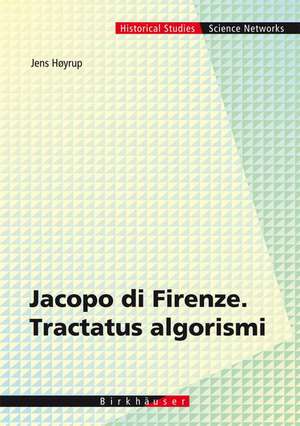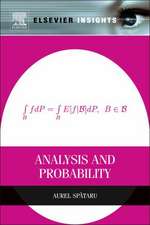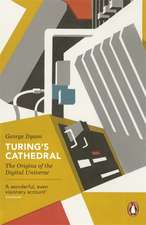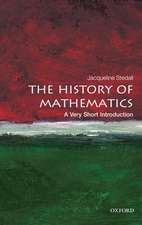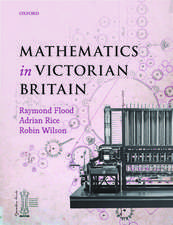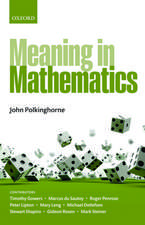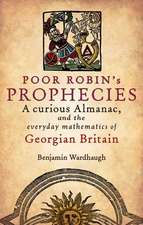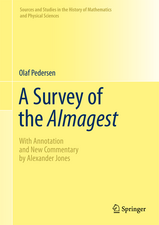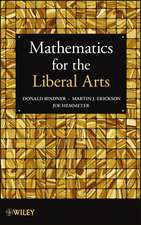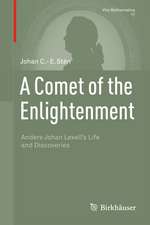Jacopo da Firenze's Tractatus Algorismi and Early Italian Abbacus Culture: Science Networks. Historical Studies, cartea 34
Autor Jens Høyrupen Limba Engleză Hardback – 17 sep 2007
Din seria Science Networks. Historical Studies
- 18%
 Preț: 796.31 lei
Preț: 796.31 lei - 15%
 Preț: 652.49 lei
Preț: 652.49 lei - 18%
 Preț: 787.15 lei
Preț: 787.15 lei -
 Preț: 385.25 lei
Preț: 385.25 lei -
 Preț: 489.30 lei
Preț: 489.30 lei - 15%
 Preț: 476.75 lei
Preț: 476.75 lei -
 Preț: 389.31 lei
Preț: 389.31 lei - 15%
 Preț: 699.59 lei
Preț: 699.59 lei - 15%
 Preț: 660.37 lei
Preț: 660.37 lei - 15%
 Preț: 531.59 lei
Preț: 531.59 lei - 24%
 Preț: 909.27 lei
Preț: 909.27 lei -
 Preț: 396.24 lei
Preț: 396.24 lei - 18%
 Preț: 903.17 lei
Preț: 903.17 lei -
 Preț: 382.36 lei
Preț: 382.36 lei -
 Preț: 395.25 lei
Preț: 395.25 lei - 15%
 Preț: 647.73 lei
Preț: 647.73 lei - 15%
 Preț: 702.87 lei
Preț: 702.87 lei - 15%
 Preț: 674.74 lei
Preț: 674.74 lei - 15%
 Preț: 655.60 lei
Preț: 655.60 lei - 15%
 Preț: 650.19 lei
Preț: 650.19 lei - 15%
 Preț: 644.82 lei
Preț: 644.82 lei - 15%
 Preț: 646.62 lei
Preț: 646.62 lei - 18%
 Preț: 1119.08 lei
Preț: 1119.08 lei - 18%
 Preț: 1135.46 lei
Preț: 1135.46 lei - 20%
 Preț: 596.59 lei
Preț: 596.59 lei - 15%
 Preț: 649.06 lei
Preț: 649.06 lei - 20%
 Preț: 567.63 lei
Preț: 567.63 lei - 15%
 Preț: 639.37 lei
Preț: 639.37 lei -
 Preț: 399.12 lei
Preț: 399.12 lei - 18%
 Preț: 1390.11 lei
Preț: 1390.11 lei -
 Preț: 361.03 lei
Preț: 361.03 lei - 18%
 Preț: 1395.63 lei
Preț: 1395.63 lei - 15%
 Preț: 642.36 lei
Preț: 642.36 lei - 15%
 Preț: 648.24 lei
Preț: 648.24 lei - 15%
 Preț: 649.06 lei
Preț: 649.06 lei -
 Preț: 392.37 lei
Preț: 392.37 lei
Preț: 595.48 lei
Preț vechi: 744.35 lei
-20% Nou
Puncte Express: 893
Preț estimativ în valută:
113.94€ • 118.98$ • 94.09£
113.94€ • 118.98$ • 94.09£
Carte tipărită la comandă
Livrare economică 11-17 aprilie
Preluare comenzi: 021 569.72.76
Specificații
ISBN-13: 9783764383909
ISBN-10: 3764383909
Pagini: 482
Ilustrații: XII, 482 p.
Dimensiuni: 165 x 235 x 32 mm
Greutate: 0.98 kg
Ediția:2007
Editura: Birkhäuser Basel
Colecția Birkhäuser
Seria Science Networks. Historical Studies
Locul publicării:Basel, Switzerland
ISBN-10: 3764383909
Pagini: 482
Ilustrații: XII, 482 p.
Dimensiuni: 165 x 235 x 32 mm
Greutate: 0.98 kg
Ediția:2007
Editura: Birkhäuser Basel
Colecția Birkhäuser
Seria Science Networks. Historical Studies
Locul publicării:Basel, Switzerland
Public țintă
ResearchCuprins
Jacopo, His Treatise, and Abbacus Culture.- Three Manuscripts.- The Abbacus Tradition.- The Contents of Jacopo’s Tractatus.- Algebra.- Jacopo’s Material and Influence.- The Vatican Manuscript Edition and Translation.- Edition and Translation Principles.- The Text.
Textul de pe ultima copertă
In the city republics of Renaissance Italy, it was a common practice among the merchant class to send sons for a two-year course of study at an "abbacus school", where they learned practical, mostly commercial mathematics, known as abbaco. From this school institution, several hundred manuscripts survive, all in Italian, often containing not only what the masters needed in their teaching but also algebra or other advanced mathematical material. A signal feature of the book by Jens Høyrup is the first translation of one of these abbacus manuscripts into English.
The abbacus books have long been supposed to be reduced versions of Leonardo Fibonacci’s Liber abbaci. Analysis of early abbacus books, not least of the first specimen treating of algebra – Jacopo da Firenze’s Tractatus algorismi from 1307 – shows instead that abbacus mathematics was an exponentof a more widespread culture of commercial mathematics, already known by Fibonacci, and probably flourishing in Provence and/or Catalonia before it reached Italy. Abbacus algebra – eventually the main inspiration for the algebraic breakthrough of the 16th and 17th centuries – was inspired from a Romance-speaking region outside Italy, most likely located in the Provençal-Catalan area, and ultimately from a similar practitioners’ level of Arabic mathematics.
The book contains, along with the English translation, an edition of Jacopo’s Tractatus and a commentary analyzing Jacopo’s mathematics and its links to Provençal, Catalan, Arabic, Indian and Latin medieval mathematics. It will provide historians of mathematics and mathematics teachers with a new perspective on a period and on processes which eventually reshaped the whole mathematical enterprise in the 17th century.
The abbacus books have long been supposed to be reduced versions of Leonardo Fibonacci’s Liber abbaci. Analysis of early abbacus books, not least of the first specimen treating of algebra – Jacopo da Firenze’s Tractatus algorismi from 1307 – shows instead that abbacus mathematics was an exponentof a more widespread culture of commercial mathematics, already known by Fibonacci, and probably flourishing in Provence and/or Catalonia before it reached Italy. Abbacus algebra – eventually the main inspiration for the algebraic breakthrough of the 16th and 17th centuries – was inspired from a Romance-speaking region outside Italy, most likely located in the Provençal-Catalan area, and ultimately from a similar practitioners’ level of Arabic mathematics.
The book contains, along with the English translation, an edition of Jacopo’s Tractatus and a commentary analyzing Jacopo’s mathematics and its links to Provençal, Catalan, Arabic, Indian and Latin medieval mathematics. It will provide historians of mathematics and mathematics teachers with a new perspective on a period and on processes which eventually reshaped the whole mathematical enterprise in the 17th century.
Caracteristici
Abbacus text in late medieval Italian with an English translation Extensive discussion of the contents and its location within early abbacus culture Includes supplementary material: sn.pub/extras
